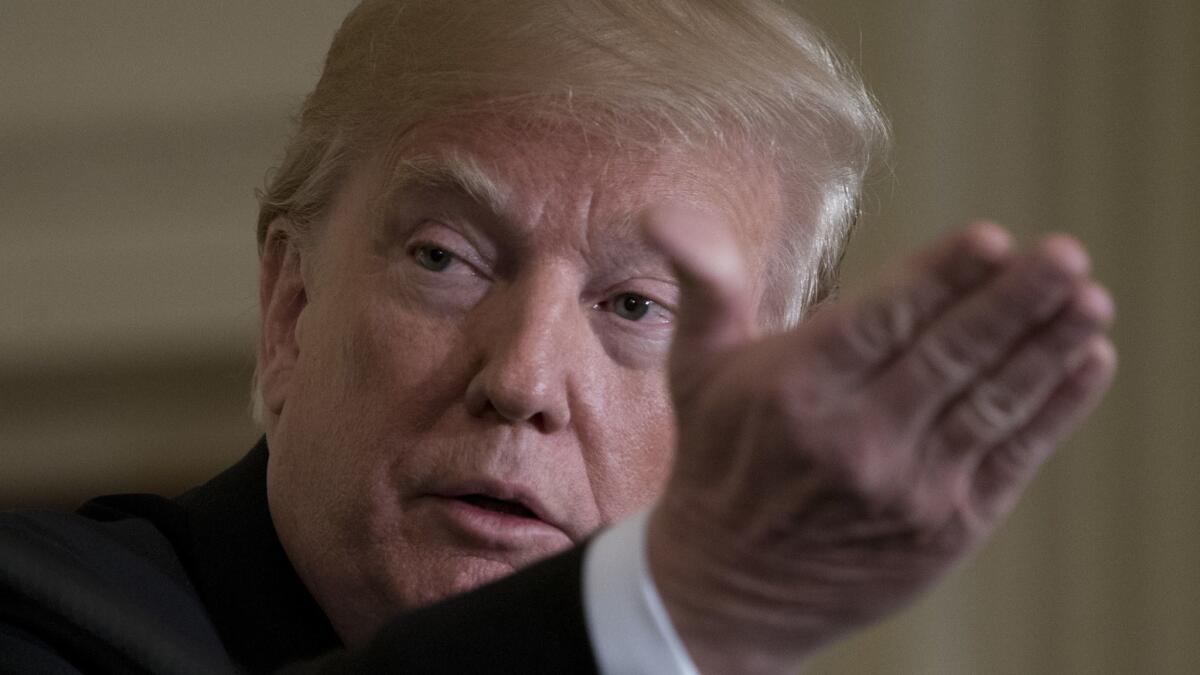Trump instructs military to begin planning for withdrawal from Syria

President Trump has instructed military leaders to prepare to withdraw U.S. troops from Syria but has not set a date for them to do so, according to a senior administration official.
In a meeting with top national security officials Tuesday, Trump stressed that U.S. troops can be involved in current training tasks for local forces to ensure security in areas liberated from Islamic State, the official said.
But the president said the U.S. mission would not extend beyond the destruction of Islamic State, and that he expects other countries, particularly wealthy Arab states in the region, to pick up the task of paying for reconstruction of stabilized areas, including sending their own troops, if necessary.
Trump on Tuesday had repeated his desire to quickly “get out” of Syria, even as his top commander for the Middle East outlined the need for an ongoing military presence there.
Trump said at a White House news conference that “I want to get out. I want to bring our troops back home.”
The United States, he said, had gotten “nothing out of $7 trillion [spent] in the Middle East over the last 17 years,” a calculation that apparently included the Afghanistan war against the Taliban in South Asia, where he last year approved a U.S. troop increase.
“So, it’s time. It’s time. We were very successful against ISIS,” Trump said, using an acronym for Islamic State. “But sometimes it’s time to come back home, and we’re thinking about that very seriously, OK?”
Trump has used the $7 trillion figure many times, including during his campaign, although numerous experts put the figure at about half that, beginning in Afghanistan in 2001 and continuing through U.S. military operations in Pakistan, Iraq and Syria. The figure also would include substantial costs tied to veterans’ care and disability benefits, and war-related domestic and diplomatic security measures.
Many military officials were taken aback by Trump’s stated intent, first mentioned last week, to withdraw from Syria. In a speech ostensibly devoted to his domestic infrastructure plans, Trump told a rally in Ohio on Thursday that U.S. forces would “be coming out of Syria, like, very soon.”
On Tuesday, speaking at the U.S. Institute of Peace, Gen. Joseph L. Votel, head of U.S. Central Command, said, “A lot of very good military progress has been made over the last couple of years, but the hard part, I think, is in front of us.” Upcoming efforts, he said, include the military’s role in “stabilizing [Syria], consolidating gains” and “addressing long-term issues of reconstruction” after the defeat of Islamic State.
Votel, along with Defense Secretary Jim Mattis, also has repeatedly said in recent months that U.S. troops would be staying in Syria for the foreseeable future to guarantee stability and a political resolution to the civil war, which initially created space for Islamic State to advance.
There are about 2,000 U.S. troops there, advising and assisting local proxy forces and directing U.S. airstrikes against Islamic State forces. Trump described that mission as “close to 100%” accomplished, while Votel said that “well over 90%” of Syria had been “liberated” from the militants, even as “the situation continues to become more and more complex” and “other underlying challenges” become more apparent.
Among those challenges are the need to stabilize areas cleared of militants to prevent their reappearance, to forge a political solution that will end Syria’s civil war without ceding power to Russia and Iran, and resolving U.S. difficulties with neighboring Turkey.
According to State Department coalition envoy Brett McGurk, fighting against Islamic State in Syria is ongoing in two areas close to the Iraqi border, one east of Shaddadi and the other in the far southeast at Bukamal. The latter has been the site of most recent U.S. airstrikes in Syria.
The effort against the remaining militants has been slowed on the ground, Votel acknowledged, by the departure of members of the principal U.S. proxy, the Kurdish-dominated Syrian Democratic Forces. Many of the Syrian Kurdish fighters have left their U.S.-backed units in the southeast to head to Afrin in northwest Syria, where their compatriots are fighting against Turkey and its proxy, the rebel Free Syrian Army.
“What this means for us,” Votel said, “is that we’re going to have to look at the ways that we keep pressure on ISIS and continue to develop mechanisms on the ground that help us de-escalate the situation” in Afrin, “so that [it] can be addressed by discussion and diplomacy as opposed to fighting.”
More to Read
Start your day right
Sign up for Essential California for news, features and recommendations from the L.A. Times and beyond in your inbox six days a week.
You may occasionally receive promotional content from the Los Angeles Times.






